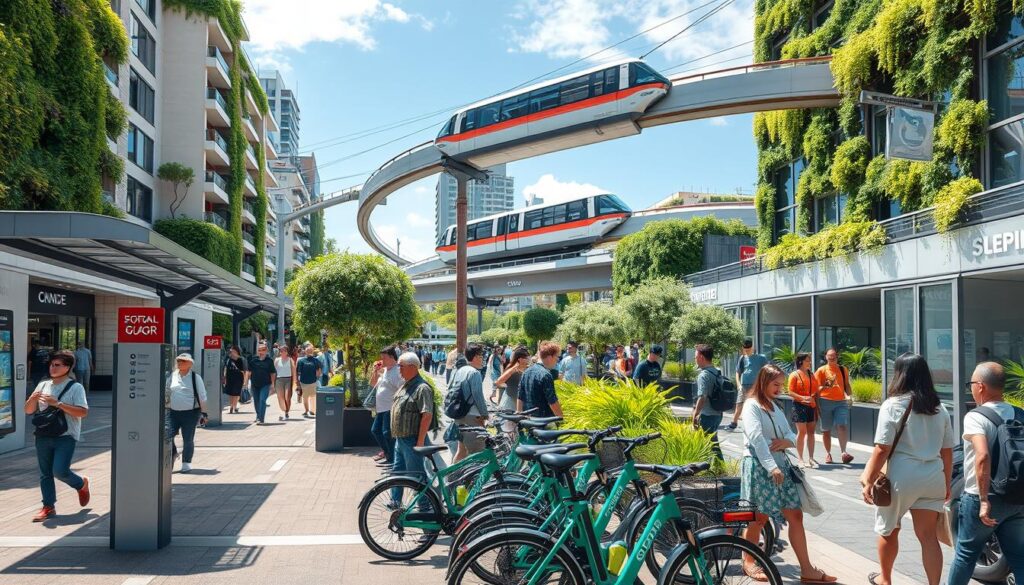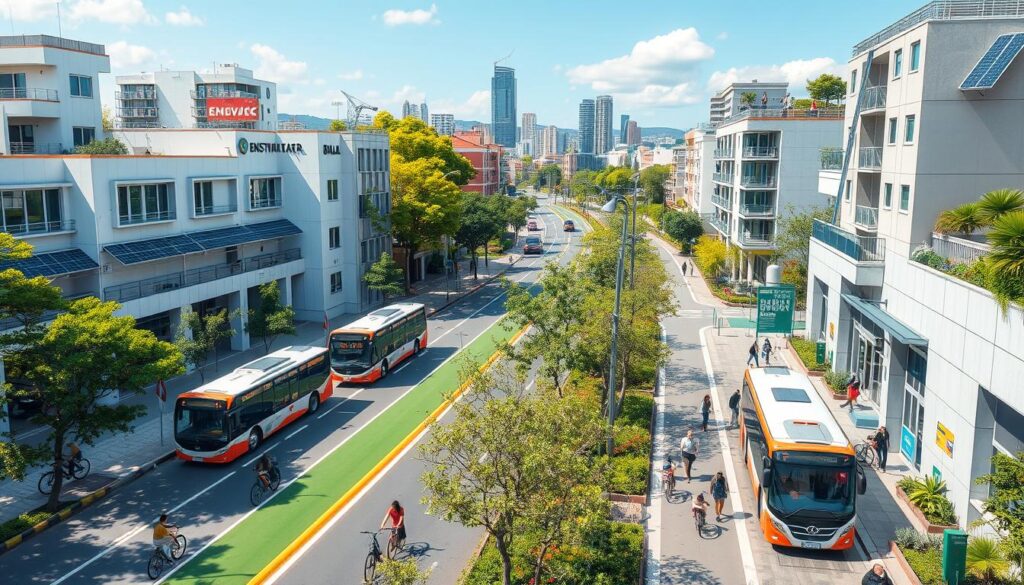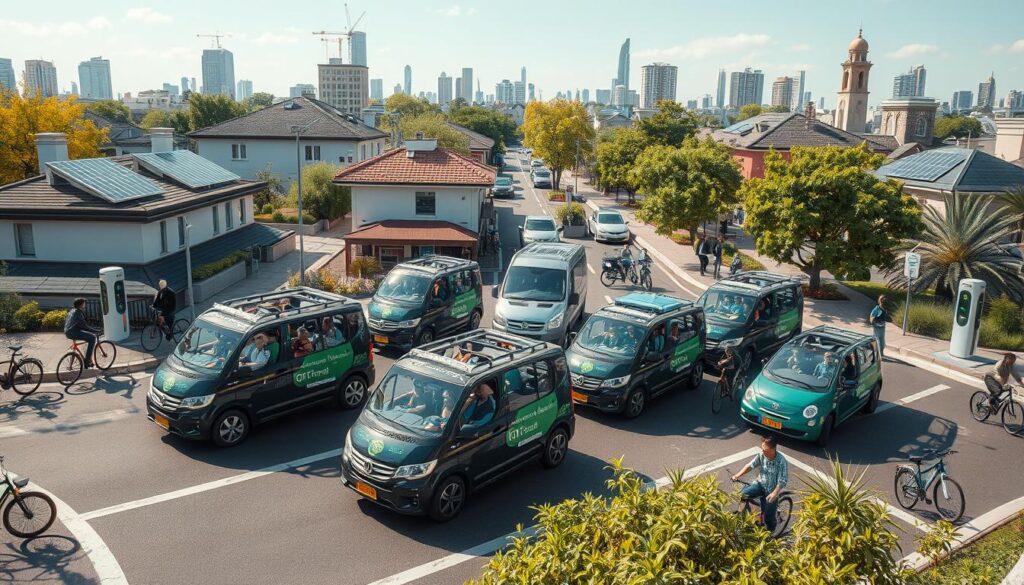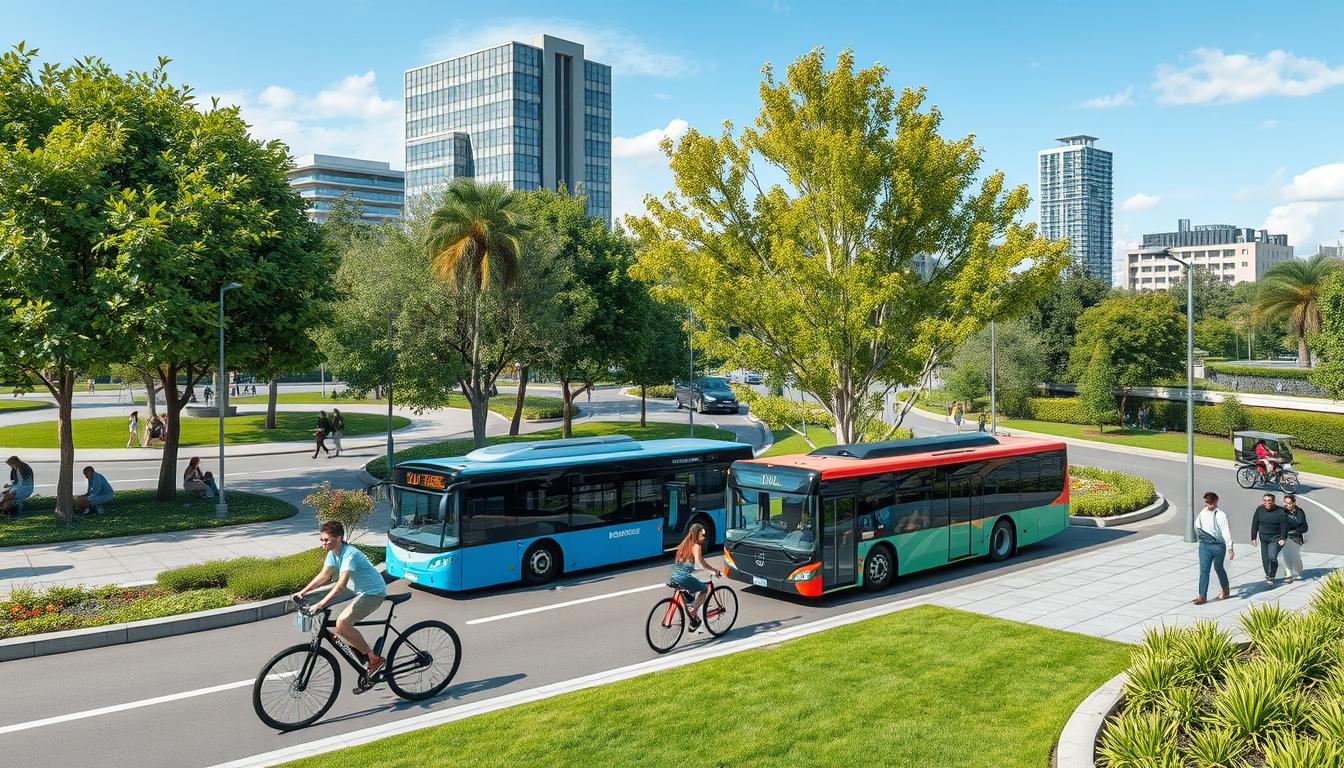Have you ever thought about how your daily commute affects the planet? In today’s world, we often ignore the environmental impact of our travel. With transportation causing a big part of global pollution, it’s key to choose green transport options. This article will look at different ways to travel green, from walking and cycling to electric cars and public transport.
Let’s explore how we can make a difference in our daily lives. Together, we can help make the future more sustainable.
Key Takeaways
- Increased walking and cycling during the lockdown significantly lowered air pollution levels.
- Public transport, like buses, can efficiently reduce traffic by taking numerous cars off the road.
- Investments in sustainable transportation create job opportunities and promote economic growth.
- Electric vehicles are becoming more prevalent, offering a cleaner alternative to conventional cars.
- Carpooling and ride-sharing help to minimize individual carbon footprints and traffic congestion.
- Switching to eco-friendly commuting choices not only benefits the environment but also improves personal health and well-being.
Understanding Sustainable Travel
Sustainable travel means making choices that protect our planet and respect local cultures. It’s about using transport that doesn’t harm the environment. This way, we help make the world a healthier place and support vibrant communities.
Looking for environmentally friendly travel options can change our adventures. It lets us explore while keeping the places we love safe.
Definition of Sustainable Transport
Sustainable transport is about traveling in ways that don’t hurt the environment or people. Using public transport, cycling, and walking are key. These choices help cut down on pollution and save resources.
By choosing these options, we reduce our carbon footprint. This helps us move towards cleaner, greener travel.
Importance of Eco-Friendly Choices
Choosing eco-friendly transport is crucial for many reasons. Using public transit and cycling reduces the negative impacts of tourism. This includes less traffic, noise, and damage to nature.
By doing this, we help protect wildlife and support local businesses. More tourists using public transport means they spend more at local shops. This supports the local economy and helps communities thrive.

Benefits of Sustainable Transport Options
Choosing sustainable transport options has many benefits, especially for the environment and our health. By picking eco-friendly transport, we help save our planet and improve our health. Here are some key advantages.
Environmental Protection
Sustainable transport is great for the environment. Traditional travel methods, like those using fossil fuels, pollute the air and release harmful gases. In the U.S., transportation is responsible for nearly 30% of greenhouse gas emissions.
85 million people live in areas with bad air pollution, mainly because of how we move around. But, using trains instead of cars or planes cuts down emissions by 70 to 80%. Public transport also pollutes less than private cars, helping to clean the air.
Health Benefits
Sustainable transport is good for our health too. Activities like cycling and walking make us more active, which is good for our hearts and overall health. The World Health Organization says air pollution causes 7 million deaths worldwide each year.
By choosing green transport, we lower our carbon footprint and make the air cleaner. In cities, using public transport can cut down CO2 emissions by 4,800 pounds a year for those who commute 20 miles daily. This helps our health and makes our environment cleaner.

Sustainable Transport Options: Walking and Cycling
Walking and cycling are top choices for eco-friendly travel. They cut down on carbon emissions and boost our health. Plus, they make cities more lively.
Walking: The Cleanest Mode of Travel
Walking is the cleanest way to get around, with no emissions. In cities like Dar es Salaam and Nairobi, 70% of trips are on foot. It’s great for your heart, builds community, and reduces traffic.
Urban planners now focus on making cities walkable. This makes it easier to get to public transport. People living close to stations are more likely to walk there.
Cycling: Eco-Friendly Commuting
Cycling is a top choice for green travel, loved in Asian and African cities. In the Netherlands, 50% of train trips start with a bike ride. Cities are improving bike paths to encourage cycling.
This move promotes health and cuts air pollution. Public transport, walking, and cycling are more efficient than cars in cities. By embracing biking, cities can reduce traffic and pollution.

Public Transportation: A Greener Alternative
Public transportation is key to a greener city. It offers a low-carbon way to travel. Millions use trains, buses, and ferries, cutting down on emissions.
This choice makes our air cleaner and our cities less crowded. It makes our cities better places to live.
Impact of Public Transport on Carbon Emissions
Choosing public transport over cars cuts down on emissions a lot. One person switching can save over 48,000 pounds of CO2 a year. That’s a big reduction for a family.
Public transport saves about 37 million metric tons of CO2 each year. That’s like the emissions from 4.9 million homes.
Benefits of Using Trains, Buses, and Ferries
Public transport is good for your wallet and the planet. It can save up to 30% of carbon emissions. Plus, it saves a lot of gasoline.
U.S. public transit saves 6 billion gallons of gasoline each year. This also cuts down on greenhouse gas emissions. It’s a big job creator, supporting nearly 450,000 jobs.
| Transportation Method | Annual CO2 Savings (in pounds) | Gasoline Savings (in gallons) |
|---|---|---|
| Public Bus | 1,000 | 6,000 |
| Train | 2,500 | 12,000 |
| Ferry | 1,500 | 8,000 |

Public transport is getting better with new funding. The Bipartisan Infrastructure Law is helping. It’s a step towards a cleaner future.
This effort is part of the U.S. goal to make all transportation emissions-free by 2050.
Eco-Friendly Vehicles: Electric and Hybrid Cars
Looking into electric and hybrid cars shows big wins for the planet and your wallet. Electric vehicles (EVs) are a great way to use less oil and cut down on pollution. With new tech and more people wanting them, they’re becoming a top pick for those who care about the environment.
Advantages of Electric Vehicles (EVs)
Electric vehicles have many benefits that make them a smart choice today. Here are some key points:
- Reduced Fuel Costs: EVs can save a lot on gas money.
- Lower Emissions: EVs make much less carbon dioxide, with only 161 grams per mile, compared to gas cars.
- Quality of Life: They’re quieter, making cities less noisy.
- Impressive Incentives: Many places offer money back to help you buy an EV.
Government Incentives for Electric Vehicle Adoption
Many U.S. governments are pushing for cleaner cars with incentives. These include tax breaks, subsidies, and cheaper charging. For example, New York City has added more charging spots, making EVs even more appealing.
| Vehicle Type | CO2 Emissions (grams/mile) | Potential Lifetime Savings |
|---|---|---|
| Standard Car | 374 | N/A |
| Hybrid Car | 257 | N/A |
| Electric Car | 161 | $21,500 |
| Electric Scooter | 8 | N/A |
| E-bike | 8 | N/A |
Choosing electric and hybrid cars is a big step towards a cleaner future. They help lower emissions and improve air quality, and they save money too. As technology keeps getting better, choosing these green options is more rewarding than ever.

Carpooling and Ride Sharing: Collaborative Green Travel Solutions
Carpooling and ride-sharing are key to reducing our carbon footprint. Many of us drive alone for nearly half of our car trips. Sharing rides cuts down on vehicles, easing traffic and lowering emissions.
Reducing Carbon Footprint with Carpooling
Choosing carpooling cuts down on carbon emissions. Cars and trucks are a big part of U.S. emissions. Replacing ten cars with one shared vehicle could cut emissions by 41% by 2050.
Car sharing also builds social bonds. It can make commuting safer and more trustworthy, thanks to digital platforms and ratings.
Popular Ride-Sharing Apps and Services
Many apps make it easier to choose green travel. Always share ride details with someone you trust. Uber and Lyft have safety features for carpooling.
Organizations like Fleet Forum aim to increase vehicle sharing by 2026. This will help reduce emissions and improve air quality.

Ride-sharing has many benefits. It makes air cleaner and streets safer. It’s also a cost-effective option for those without cars.
I urge everyone to try carpooling for their daily commute. It’s a green choice that benefits everyone.
| Impact of Carpooling | Statistics |
|---|---|
| Personal car trips with one occupant | ~50% of 1.1 billion trips |
| Transportation’s share of U.S. greenhouse gas emissions | ~30% |
| Potential reduction in carbon footprint with shared cars | 41% by 2050 |
| Safety improvement | Reduces road accidents by ~50% |
| Access to affordable transportation | Helps reduce mobility inequality |
Carbon Offsetting: Taking Responsibility for Travel Emissions
As I travel, I think about how my trips affect the environment. Carbon offsetting is key in this area. It lets travelers pay for the emissions from their trips by supporting projects that cut greenhouse gases. This shows the value of choosing travel options that are good for the planet, even if it’s hard to be completely carbon-neutral.
What is Carbon Offsetting?
Carbon offsetting means buying credits to offset the carbon dioxide emissions from trips. For instance, one credit equals one metric ton of CO2e reduced. It’s a way for people and groups to help the environment while traveling.
Ways to Offset Your Carbon Footprint
There are many ways to reduce my carbon footprint. Some popular methods include:
- Investing in renewable energy projects like wind farms that help produce clean energy.
- Supporting reforestation initiatives to boost biodiversity and air quality through tree planting.
- Participating in sustainable tourism efforts, which often include carbon-neutral travel choices.
- Contributing to community-based conservation programs that help local ecosystems and economies.
By choosing these eco-friendly travel options, I can help lessen my environmental impact. I also support broader ecological preservation and encourage others to do the same. Thanks to groups like Sustainable Travel International, finding meaningful projects to support is easier.
Sustainable Urban Transportation Initiatives
Cities around the world are working hard to make transportation better and greener. As more people move to cities, finding new ways to get around is key. Many cities are now focusing on green transit options to help the environment and people’s health. Here are some great examples.
Examples of Urban Green Transit Alternatives
Many cities are now offering eco-friendly ways to travel:
- Bike-sharing programs in places like Rio de Janeiro and Frankfurt offer convenient, low-cost options for riders.
- Pedestrian-friendly developments create car-free zones and dedicated bus lanes that encourage walking and cycling.
- Electric micromobility options, such as shared electric scooters and bikes, have surged in popularity, enhancing flexible transportation for urban dwellers.
- Sustainable public transport projects, which include investments in cleaner fuels and zero-emission buses, aim to lower urban pollution levels significantly.
How Cities are Promoting Sustainable Mobility Solutions
Cities are investing in green transport and making policies to support it:
- Governments are prioritizing infrastructural improvements that support both cyclists and walkers, as seen in initiatives championed by the UN’s Share the Road program.
- Vehicle Scrapping and Recycling Programs in places like Egypt have facilitated a transition to newer, cleaner taxis, effectively reducing emissions.
- Educational campaigns are helping raise awareness about the benefits of sustainable travel practices, inviting more residents to consider eco-friendly commuting choices.
- Funding for public transportation has become a focal point, aiming to elevate accessibility levels across urban areas, which is an essential aspect of sustainable transport.
| City | Initiative | Focus |
|---|---|---|
| Rio de Janeiro | Bike-sharing program | Encouraging cycling |
| Frankfurt | Electric bus fleet | Reducing emissions |
| Guatemala City | Enhanced biking infrastructure | Supporting eco-friendly commuting |
| Egypt | Vehicle Scrapping and Recycling | Transition to clean vehicles |
Choosing Eco-Conscious Travel Options for Business Trips
Business travel has a big impact on the environment, mainly through carbon emissions from flights and cars. Choosing eco-friendly travel for work trips is key to reducing these effects. Companies are now seeing the value in green travel, as it boosts their social responsibility and image.
Impact of Business Travel on the Environment
The tourism industry is a big source of greenhouse gas emissions, with transport being a major part. About three-quarters of these emissions come from travel by air and land. As more people learn about climate change, they look for ways to travel greener. Options include electric scooters, hybrid cars, or using public transport in green cities.
Corporate Social Responsibility in Travel Choices
Companies that focus on green travel show they care about the planet. They might work with groups like CWT and Thrust Carbon to book travel responsibly. This not only makes their reputation better but also meets the growing need for eco-friendly services.
By supporting local businesses and choosing green hotels, companies can make a bigger difference. This helps the local economy and makes business travel more sustainable.
Conclusion
Looking back at our talk on green travel, it’s clear we must choose sustainable transport. This helps the environment and improves our health. By walking, cycling, or using public transport, we help our planet.
Transportation is a big problem, with 26% of UK greenhouse gas emissions coming from it. Making smart travel choices is more important than ever.
Switching to electric vehicles can cut down on emissions. Eco-friendly companies gain trust from customers who care about the planet. Rail travel is also a good choice, being 75% cleaner than cars and trucks.
Choosing green transport is not just for us; it’s for our future. We can all be part of this change. Let’s support new ideas, improve biofuels, and encourage a greener way of life. Together, we can make a big difference.
FAQ
What are some sustainable transport options I can choose from?
You can walk, cycle, or use public transport like buses and trains. Carpooling and electric vehicles are also good choices. Each option helps reduce your carbon footprint and supports eco-friendly commuting.
Why is sustainable travel important?
Sustainable travel is key because it cuts down on pollution and carbon emissions. It protects our natural resources, supports local communities, and promotes biodiversity.
How does cycling promote a healthier lifestyle?
Cycling boosts your heart health and overall well-being. It also makes the air cleaner by reducing traffic and pollution. So, it’s great for your health and the environment.
What are the benefits of public transportation?
Public transport cuts down on carbon emissions and air pollution. It also reduces traffic and saves money on fuel and maintenance.
Are electric vehicles really eco-friendly?
Yes, electric vehicles (EVs) are eco-friendly because they have low emissions. They also help reduce our reliance on fossil fuels. With government incentives, EVs are becoming a popular choice for green travel.
How can carpooling contribute to sustainable mobility?
Carpooling means sharing rides, which lowers the number of vehicles on the road. It reduces carbon footprints, traffic congestion, and emissions.
What is carbon offsetting and how does it work?
Carbon offsetting helps balance out carbon emissions by funding projects that reduce greenhouse gases. This can include renewable energy or tree-planting. It’s a way to take responsibility for our environmental impact.
How are cities promoting sustainable urban transportation?
Cities are improving bike-sharing programs, public transport, and pedestrian areas. These efforts encourage green transit and create healthier urban spaces.
What can businesses do to adopt eco-conscious travel options?
Businesses can encourage employees to use public transport, carpool, or bike. By doing so, they can reduce their environmental impact and enhance their reputation.
Source Links
- What are my sustainable transport options?
- a guide to achieving sustainable transportation
- Sustainable transportation: Lowering your impact while traveling — Sea Going Green
- Eco-Friendly Transportation in Tourism: Embrace Sustainability
- How to travel better: a beginner’s guide to sustainable travel in 2023 and beyond
- How Sustainable Transportation Can Positively Impact the Future – Edenred Benefits
- 8 Benefits of Sustainable Transportation | Environment.co
- 6 Benefits of Sustainable Transportation
- Six actions to enable walking, cycling and public transport for people and planet
- Sustainable Transportation and Fuels
- Environmental Benefits of Public Transit | The Environment | About KCATA
- 6 Environmental Benefits of Sustainable Public Transportation
- Toyota’s Commitment to Sustainability: A Look at Hybrid and Electric Models | Phil Long Toyota
- Eco-Friendly Options: Exploring Electric And Hybrid Cars In New York City
- What are the most environmentally friendly modes of transportation?
- Carpool for the Climate and Community
- Carpooling – Climate Action Accelerator
- Corporate Carpooling – Green, collaborative corporate commutes.
- Carbon Offsets: Frequently Asked Questions – Sustainable Travel International
- How to travel more sustainably
- Carbon Offsets
- The Road to Sustainable Transport
- 8 Sustainable Transport Solutions to Improve Mobility in the US
- Environmental consciousness: How travelers can make a difference
- Guide to Sustainable and Eco-Friendly Travel
- How To Cater To Eco-Conscious Travellers – Package Travel Protection
- Transport and sustainability
- Sustainable transportation: what are the best solutions?




